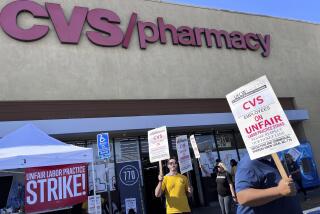Safeway’s Sales Slump Expected to Continue
Safeway Inc., the parent of Vons and Pavilions, said Thursday that it could not yet estimate the financial hit from the Southern California grocery strike, but that the chain’s sales slump was continuing in the rest of the country in the fourth quarter.
The Pleasanton, Calif.-based chain, with 1,702 stores in the U.S. and Canada, also said its 2004 profit would lag behind analysts’ forecasts, even without accounting for the strike.
Vons and Pavilions were struck Oct. 11 by the United Food and Commercial Workers union, which prompted Safeway’s co-bargainers in the contract dispute -- Kroger Co.’s Ralphs chain and Albertsons Inc. -- to lock out their unionized workers.
About 70,000 employees have been idled by the strike and lockout at the chains’ stores in Southern and Central California, including those at 293 Vons and Pavilions stores. Both sides met with a federal mediator Thursday and are expected to meet again today, said John Arnold, a spokesman for the Federal Mediation and Conciliation Service.
A clearer view of the effects of the strike could come today, when Albertsons reports its fiscal third-quarter earnings and holds a call with analysts to elaborate on the results. Albertsons last month stopped offering financial guidance to Wall Street, citing the uncertainty from the labor dispute.
Safeway -- buffeted by the weak economy, rising costs and growing competition from discount mass merchandisers such as Wal-Mart Stores Inc. -- said its identical-store sales in the fourth quarter through Nov. 29 fell 1.2% from a year earlier. There is still one more month remaining in the quarter. The figure excludes sales of gasoline.
Those sales are a key industry gauge because they exclude new, closed and replacement stores. They include sales at Safeway’s other subsidiaries, such as Dominick’s in the Chicago area.
Safeway’s identical-store sales have been dropping for several quarters. However, the decline in the fourth quarter so far is an improvement from the 2.9% in last year’s fourth quarter.
In terms of profit, Safeway said it expected to earn $1.95 to $2.03 a share next year, excluding the effects of the strike. A survey of 17 analysts by Thomson First Call showed their consensus estimate was $2.05.
“The soft economy has continued to impact our business, and it is unclear when unemployment levels in our markets will improve,” Safeway Chief Executive Steven Burd said.
The lower forecast “is disappointing” and in part reflects “skyrocketing health-care costs” for Safeway’s workers, analyst Mark Husson of Merrill Lynch & Co. said in a bulletin to clients Thursday.
Those costs are at the heart of the labor dispute. The supermarkets and many analysts contend that the chains must obtain lower health-care costs, in part by requiring workers to start paying premiums for their coverage, to stay competitive with nonunion chains. The UFCW is vigorously fighting that effort.
--- UNPUBLISHED NOTE ---
On February 12, 2004 the United Food and Commercial Workers Union, which had stated repeatedly that 70,000 workers were involved in the supermarket labor dispute in Central and Southern California, said that the number of people on strike or locked out was actually 59,000. A union spokeswoman, Barbara Maynard, said that 70,000 UFCW members were, in fact, covered by the labor contract with supermarkets that expired last year. But 11,000 of them worked for Stater Bros. Holdings Inc., Arden Group Inc.’s Gelson’s and other regional grocery companies and were still on the job. (See: “UFCW Revises Number of Workers in Labor Dispute,” Los Angeles Times, February 13, 2004, Business C-11)
--- END NOTE ---
More to Read
Inside the business of entertainment
The Wide Shot brings you news, analysis and insights on everything from streaming wars to production — and what it all means for the future.
You may occasionally receive promotional content from the Los Angeles Times.










